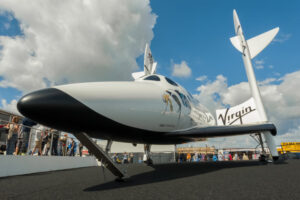Just realize any money you put into Virgin Galactic is purely speculative. Before you hit the buy button, blow it a parting kiss goodbye. It very well could go lost in space.
As we wait with bated breath for the launch of Elon Musk’s SpaceX rocket, more than a few folks are wondering, “How do I invest in this new, private-space travel trend?”
It’s not easy.
Two of the three companies promising to one day launch average Joes into space are privately held. Elon Musk controls SpaceX, while Amazon’s billionaire (possibly first-ever trillionaire) founder, Jeff Bezos, owns Blue Origin.
So please, don’t call your broker and ask how you can get in on their action. You’ll be laughed off the phone.
The third is Sir Richard Branson’s Virgin Galactic (NYSE: SPCE).
You and I can buy shares of this publicly traded company right now, which came to market via a reverse merger last year. It’s the first stock — and for now the only stock — retail investors can buy in the “space tourism” segment.

M&M Chief Investment Strategist Adam O’Dell
But is Virgin Galactic a good investment?
To answer that, let’s first draw a distinction between investment and speculation…
The Graham-Dodd-Buffett school defines an investment operation as one which, “upon thorough analysis, promises safety of principal and a satisfactory return.”
“Safety of principal” is the key phrase here. When Warren Buffett invests $10 million in a business, he fully expects to get that $10 million back someday, in addition to some “satisfactory” return.
On the other hand, speculators are typically not able to give or gain any assurances of “safety of principle.”
If you’re speculating on the price of gold going from $1,800 per ounce to $3,000… there is no such thing as safety of principal. You’re merely speculating on the change in price. If you’re right, you make money… if you’re wrong, you lose money.
Back to Virgin Galactic…
If you must make a play on this first-ever space tourism company, please do so fully understanding that you are speculating.
While I’ve always admired Branson as a competent and innovative businessman — and my wife and I loved Virgin America’s nonstop flight from Fort Lauderdale to Los Angeles, before Alaska Air took over — the success of his latest space-travel endeavor is far from certain. As such, there is no safety of principle.
The company is not profitable and at this stage is only earning meager ancillary revenues. Sure, you may have read how the company could potentially take in $100 million on the sale of $250,000-per-head tickets for a wild ride around space.
But since the refundable hold fee for those tickets was a mere $1,000, meaningful revenues are very much speculative.
How to Play Virgin Galactic
 It’s nearly impossible to value this company, and even its current and potential growth rates require a shot in the dark.
It’s nearly impossible to value this company, and even its current and potential growth rates require a shot in the dark.
I’ve ranked Virgin Galactic against 66 U.S. aerospace and defense companies on “value,” “quality” and “growth” factors… it lands at the bottom of the list.
Even on technical price factors, such as “momentum,” “size” and “volatility,” the stock ranks poorly.
So if you’re looking for a solid stock to invest in — one that ranks highly on the major factors that are known to drive performance — Virgin Galactic is not it.
All that said, I’m not here to squash your daydreams…
Maybe you’re a big fan of space travel and you just can’t help but to get in on the action. Or maybe you’re tempted to make a $250,000 profit trading SPCE shares… which you intend to use for your very own ticket into space.
The odds of Virgin Galactic shares shooting to the moon are not zero.
In January, P.C. (“pre-Corona”)… my Cycle 9 Alert trend-and-momentum algorithm triggered a buy signal on Virgin Galactic. Shares had already climbed strongly from around $7.50 in early December to $15 when that signal arrived on Jan. 17.
And over the next month, the stock rocketed to an intraday high of $42.49!
Think about that… in the course of just three months, shares of Virgin Galactic doubled — and then nearly tripled the already-doubled price!
It’s tough to say what the stock would have done in the absence of the COVID-19 pandemic. Its all-time intraday high was made on Feb. 20, alongside the peak in the broader stock market. Shares came back to earth, hitting $10 in mid-March, before bouncing around between $15 and $20 since.
All told, Virgin Galactic’s stock chart looks more like the printout of an electrocardiogram (EKG) than a rocket in orbit.
Could it take off again? Sure it could! And if it does, it could be big.
Just realize any money you put into Virgin Galactic is purely speculative. Before you hit the buy button, blow it a parting kiss goodbye. It very well could go lost in space.
Adam O’Dell
Chief Investment Strategist, Money & Markets
• Using his unique blend of technical and quantitative analysis, Adam’s sole focus is to find and bring you investment opportunities that return the maximum profit with minimum risk.
Editor’s note: Chief Investment Strategist Adam O’Dell’s Cycle 9 Alert service this week on Money & Markets. Click here to sign up now!
Click here to read our guide on how to trade options.




